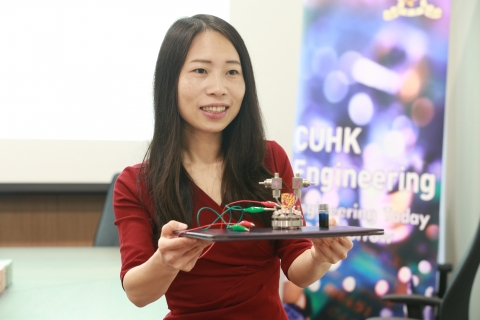Alkali metal-oxygen batteries promise high gravimetric energy densities but suffer from low rate capability, poor cycle life and safety hazards associated with metal anodes. A safe, high-rate and long-life oxygen battery that exploits a potassium biphenyl complex anode instead of the problematic potassium metal anode has recently been developed by Prof. Yi-Chun Lu, Associate Professor of the Department of Mechanical and Automation Engineering and her research team. This technology provides a safe and efficient solution for the storage of renewable energy sources such as solar and wind. The breakthrough was recently published in the world-leading scientific journal, Nature Materials, a sister journal of Nature. Scientists have been searching for a battery that can pack in more energy, with a longer life and safer than the widely used lithium-ion battery. Offering a higher energy density and lower cost, the alkali metal-oxygen batteries (e.g. Li-O2, Na-O2, K-O2) represent a promising energy storage solution for multi-scale applications including grid-scale energy storage, solar energy storage, and powering electric vehicles. However, metal-air battery systems have long been suffering from poor cycle life, unstable oxygen electrode and flammable metal electrode. These challenges have seriously impeded the development of rechargeable metal-air batteries. In the past four years, Professor Yi-Chun Lu and her team have been studying the origins of the instability of the oxygen batteries. Recently, they replaced the problematic potassium metal with an organic biphenyl anode (BpK) forming a potassium biphenyl complex-oxygen (BpK-O2) battery, which achieves an unprecedented cycle life (3,000 cycles) with a superior average coulombic efficiency of over 99.84% at a high current density of 4.0 mA cm-2. In addition, the reactions between the organic anode and bulk water or dimethyl sulfoxide (DMSO) proceed moderately without combustion, which makes the BpK-O2 battery much safer compared with the oxygen batteries based on alkali metals. Global climate change continues to affect our environment and is exacerbated by greenhouse gasses produced by fossil fuels. Developing reliable renewable energy resources is critical for the sustainable development of our society. This organic-oxygen battery could be widely applied to large-scale electricity storage, small and medium-sized charging stations, and energy storage modules for the renewable energy harvesting systems such as solar panels and wind turbines. Professor Yi-Chun Lu said, “This technology has a strong potential application in distributed energy storage, which will greatly enhance the penetration of renewables into the power grid and help us in moving away from fossil fuels. In addition, the cost of the raw materials of the organic-oxygen battery is much lower than the materials used in alkali metal and ithium-ion batteries (e.g. cobalt), leading to a significant decrease in the cost of energy storage. We hope to further improve the cell voltage and energy density of the organic-oxygen battery and apply this design knowledge to other alkali-metal-oxygen batteries.” More details: |
|


